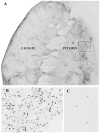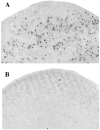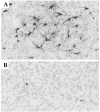Alcohol-induced neuroapoptosis in the fetal macaque brain
- PMID: 20580929
- PMCID: PMC2926181
- DOI: 10.1016/j.nbd.2010.05.025
Alcohol-induced neuroapoptosis in the fetal macaque brain
Abstract
The ability of brief exposure to alcohol to cause widespread neuroapoptosis in the developing rodent brain and subsequent long-term neurocognitive deficits has been proposed as a mechanism underlying the neurobehavioral deficits seen in fetal alcohol spectrum disorder (FASD). It is unknown whether brief exposure to alcohol causes apoptosis in the fetal primate brain. Pregnant fascicularis macaques at various stages of gestation (G105 to G155) were exposed to alcohol for 8h, then the fetuses were delivered by caesarean section and their brains perfused with fixative and evaluated for apoptosis. Compared to saline control brains, the ethanol-exposed brains displayed a pattern of neuroapoptosis that was widespread and similar to that caused by alcohol in infant rodent brain. The observed increase in apoptosis was on the order of 60-fold. We propose that the apoptogenic action of alcohol could explain many of the neuropathological changes and long-term neuropsychiatric disturbances associated with human FASD.
(c) 2010 Elsevier Inc. All rights reserved.
Figures








Similar articles
-
Alcohol-induced apoptosis of oligodendrocytes in the fetal macaque brain.Acta Neuropathol Commun. 2013 Jun 12;1:23. doi: 10.1186/2051-5960-1-23. Acta Neuropathol Commun. 2013. PMID: 24252271 Free PMC article.
-
Ethanol-induced apoptotic neurodegeneration in the developing C57BL/6 mouse brain.Brain Res Dev Brain Res. 2002 Feb 28;133(2):115-26. doi: 10.1016/s0165-3806(02)00279-1. Brain Res Dev Brain Res. 2002. PMID: 11882342
-
Role of caspase-3 in ethanol-induced developmental neurodegeneration.Neurobiol Dis. 2005 Nov;20(2):608-14. doi: 10.1016/j.nbd.2005.04.014. Epub 2005 May 31. Neurobiol Dis. 2005. PMID: 15927478
-
Ethanol-induced apoptotic neurodegeneration in the developing brain.Apoptosis. 2000 Dec;5(6):515-21. doi: 10.1023/a:1009685428847. Apoptosis. 2000. PMID: 11303910 Review.
-
Mechanisms of ethanol-induced death of cerebellar granule cells.Cerebellum. 2012 Mar;11(1):145-54. doi: 10.1007/s12311-010-0219-0. Cerebellum. 2012. PMID: 20927663 Free PMC article. Review.
Cited by
-
17β-Estradiol via SIRT1/Acetyl-p53/NF-kB Signaling Pathway Rescued Postnatal Rat Brain Against Acute Ethanol Intoxication.Mol Neurobiol. 2018 Apr;55(4):3067-3078. doi: 10.1007/s12035-017-0520-8. Epub 2017 May 2. Mol Neurobiol. 2018. PMID: 28466267
-
Neonatal exposure to phenobarbital potentiates schizophrenia-like behavioral outcomes in the rat.Neuropharmacology. 2012 Jun;62(7):2337-45. doi: 10.1016/j.neuropharm.2012.02.001. Epub 2012 Feb 15. Neuropharmacology. 2012. PMID: 22366076 Free PMC article.
-
Neonatal ethanol causes profound reduction of cholinergic cell number in the basal forebrain of adult animals.Alcohol. 2021 Dec;97:1-11. doi: 10.1016/j.alcohol.2021.08.005. Epub 2021 Aug 28. Alcohol. 2021. PMID: 34464696 Free PMC article.
-
Neurotrophins in the Brain: Interaction With Alcohol Exposure During Development.Vitam Horm. 2017;104:197-242. doi: 10.1016/bs.vh.2016.10.008. Epub 2016 Nov 29. Vitam Horm. 2017. PMID: 28215296 Free PMC article. Review.
-
Persistent dose-dependent changes in brain structure in young adults with low-to-moderate alcohol exposure in utero.Alcohol Clin Exp Res. 2012 Nov;36(11):1892-902. doi: 10.1111/j.1530-0277.2012.01819.x. Epub 2012 May 17. Alcohol Clin Exp Res. 2012. PMID: 22594302 Free PMC article. Clinical Trial.
References
-
- Adams RD, Victor M. Principles of Neurology. McGraw-Hill Inc.; New York: 1989.
-
- Aggleton JP, Brown MW. Episodic memory, amnesia, and the hippocampal-anterior thalamic axis. Behav Brain Sci. 1999;22:425–44. discussion 444-89. - PubMed
-
- Archibald SL, Fennema-Notestine C, Gamst A, Riley EP, Mattson SN, Jernigan TL. Brain dysmorphology in individuals with severe prenatal alcohol exposure. Dev Med Child Neurol. 2001;43:148–54. - PubMed
-
- Bailey BN, Delaney-Black V, Covington CY, Ager J, Janisse J, Hannigan JH, Sokol RJ. Prenatal exposure to binge drinking and cognitive and behavioral outcomes at age 7 years. Am J Obstet Gynecol. 2004;191:1037–43. - PubMed
-
- Bauer-Moffett C, Altman J. The effect of ethanol chronically administered to preweanling rats on cerebellar development: a morphological study. Brain Res. 1977;119:249–68. - PubMed
Publication types
MeSH terms
Substances
Grants and funding
LinkOut - more resources
Full Text Sources
Medical

